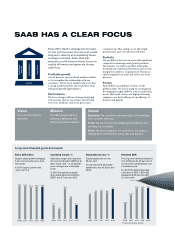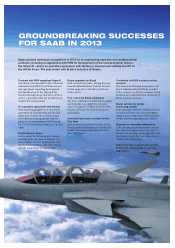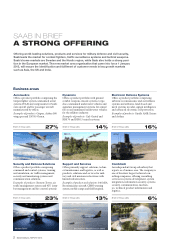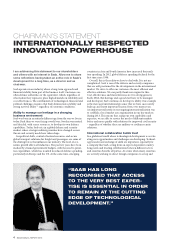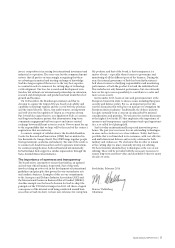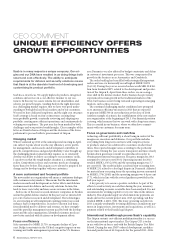Saab 2013 Annual Report Download - page 14
Download and view the complete annual report
Please find page 14 of the 2013 Saab annual report below. You can navigate through the pages in the report by either clicking on the pages listed below, or by using the keyword search tool below to find specific information within the annual report.10 SAAB ANNUAL REPORT 2013
M E G AT R E N D S
GLOBAL SHIFT, NEW REQUIRE-
MENTS FOR SECURITY SOLUTIONS
Worldwide security needs are increasingly inuenced
by economic circumstances and by the vulnerability
of every-day social functions. This means that military
resources will increasingly be put to the protection of
critical infrastructure and of strategic resource ows
of various kinds.
The World: military, economical and civil aspects
converge to a widened defence and security domain
Today’s globalised world is characterised by megatrends like
urbanisation, stronger inter-connectedness and rapid unpredicta-
ble technological advances large impact, not only in an economic
context but also aecting security policy. ere is no doubt tra-
ditional military capabilities will remain the core asset and focus
of any nation’s defence capabilities for a long term to come, but
new aspects of defence and security are gaining in importance.
In terms of global governance some major factors of change are
economic power, regionalisation and the growing importance
assigned to an evolving multi-polar world order with nation states
remaining the key actors.
As touched upon in previous annual reports, the concept of na-
tional security is widening, with nations as well as organisations
giving economic prosperity and societal functions like critical
infrastructure, and strategic ows of goods and resources a more
prominent place in national security thinking.
With this also comes a growing focus on societal resilience and
a need to keep society safe from all kinds of hazards. As a result,
in the absence of a serious threat, the resource allocation between
military defence and security aspects and non-military security,
resilience and sustainability aspects within national budgets may
change to the benet of the latter. e current stagnation, or even
decrement, of military spending in the western world and the
global demand for increased spending on infrastructure may well
be a part of such a scenario.
National militaries are becoming more involved in continuous
security and resilience work, lending support in the protection
of larger portions of a nation’s physical infrastructure than before
against threats of military force and asymmetric kinetic attacks,
including cyber-attacks. e potential aggressor could be anyth-
ing from another nation’s armed forces to terrorists or organised
crime. In the rapidly growing cyber segment, nations also use
military resources to protect digital network functionality and
intellectual property.
Naturally there is also an oensive side to this, with modern
history, research and recent exercise patterns showing a growing
interest among nation states in developing capabilities to attack
societal functions and paralysing an enemy’s civil society while
keeping lethality low.
One oen underestimated driver behind this development is
an evolving normative framework that has contributed both to a
quite drastic reduction of the magnitude of especially inter-state
wars (fewer, smaller, shorter, less lethal etc.), and to an increasing
focus on legitimacy and “just warfare”.
A generic geostrategic emphasis – urban and maritime
implications
e increasing importance of economic factors and everyday
societal operations to national security puts a geostrategic em-
phasis on places and functions crucial to society. In peace time,
guaranteeing access to the global commons and enabling strategic
ows of all kinds of resources becomes a more important mis-
sion, as does maintaining a readiness to handle natural disasters
or humanitarian catastrophes, at home or abroad. In times of
conict, cities – and more precisely their transportation and com-
munication networks (including ports and airports) as well as the
systems to supply food, water and electricity - will be tempting
targets and objects to protect. Given the layout of the world this.
also means that urban and maritime aspects will be important.
All in all, the development brings changing and/or enlarged
responsibilities for armed forces in many parts of the world,
functionally as well as geographically. It also brings new chal-
lenges and opportunities for the traditional defence and security
industry.
The Industry: challenges and opportunities
Stagnating military spending, albeit with clear regional dierences,
present a major challenge for most defence industries, but especially
for the ones based in the western world. However, the increased
focus on economic matters and sustainability also bring opportuni-
ties. In many ways civil and military aairs are converging into an
enlarged security business domain including military and civil actors
as well as public and private operators. In this context infrastructure
is key, and the overlapping civilian and military usages of and depen-
dencies on cyberspace related platforms, networks and functionali-
ties are good examples.
While remaining rmly in the defence business, traditional
defence companies can branch out to adjacent or even interlinked
business segments and make use of their high-tech skills in elds
like ISR, cyber security, technical consulting, system integration,
training, simulation and trac management to support both se-
curity, resilience and eciency. But at the same time the develop-
ment has brought new competition, with companies traditionally
seen as civilian now engaging more in the widening defence and
security market.
Another aspect to keep in mind when trying to assess the
future of defence business is that the speed of technological
advancement will change the conditions (shorter time-lines, more
unpredictability) of capability development and defence procure-
ment planning for both buyers and sellers.
Defence as a service
In many places, the introduction of new technologies as well as
the professionalisation of the armed forces increase the likelihood
of certain defence activities being bought as a service rather than
performed by military personnel. Weapons maintenance, intel-
ligence collection, analyses, administrative tasks, transportation,
support activities like housing and feeding forces, IT-services and
even operational activities like remotely ying armed UAV’s are


